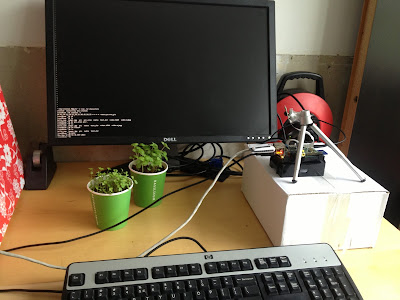Holiday project: my RaspberryPi shows that plants move!
After a few weeks of silence on this blog, a new post. Not about cucumbers, but moving plants (Do plants move? Yes, they do. Just very very slowly).
I bought a RaspberryPi before the holiday and wanted to test its capabilities and see how easy it was to program on it. So, I needed a project. After a view days of thinking I came up with making a time lapse movie (Ok, I know, not the most creative idea, but it was an idea). People might think that I would make a time lapse of the night sky, but I didn't. I am living in Delft, which is next to the Westland. This is a region with the largest surface area of the Netherlands (maybe even the world, I don't know, but you can see it from space, unlike the Great Wall of China) covered with greenhouses. At night they all turn on the lights. This makes it quite difficult to get a good view on the stars and Milky Way. So, I decided to capture other slow moving objects. Plants!!!
Another holiday project of mine is to grow my own fresh herbs. So at home little pots of green plants are scattered throughout the house. I used some of these. I had seen a Youtube movie (I think a TED talk, but I am not sure) about motion of plants and I wanted to see for myself, if this was true. Plants don't have eyes, ears, noses or mouths, so how could they interact with the surroundings without these (for humans) critical sensors. Of course they have the chloroplasts (the greenish color), so I assumed the main motion would have something to do with directing the leaves to the sun.
What I did was the following: After one morning of sunshine I would turn the pots 180 degree, such that the leaves where pointing in the opposite direction of the sun. Then I would start my time lapse recording and wait for results. For this purpose I used a RaspberryPi together with a CCD camera that I also ordered from the RaspberryPi website. On my RaspberryPi I had put the LinuxArch operating software, which made interacting with the RaspberryPi a bit like operating the servers at my work. After some searching on the internet, how to get things working (I am not a Linux wizard, but I am now some sort of first apprentice with the WWW as my mentor), I got it to work (don't use crontab, but the more simple SLEEP shell command does the job much easier). This was my setup:
Above the RaspberryPi, I attached the camera board to a camera stand with some sticky tape. This is the engineering way. Furthermore I mounted an extra external USB hard disk, where all the pictures could be stored on. I used my basil and parsley plants in the first run. The second run I added coriander and melissa to the experiment. Every five minutes a photo would be taken by the RaspberryPi and stored on the USB-hard disk. The results are shown in the next (brilliantly crafted) video:
In the side view the sun is to the right and in the front view the sun is to the back (This was just my reference frame). So you see, plants do move and can interact with the surroundings. You just need to take your time to notice it.




Reacties
Een reactie posten